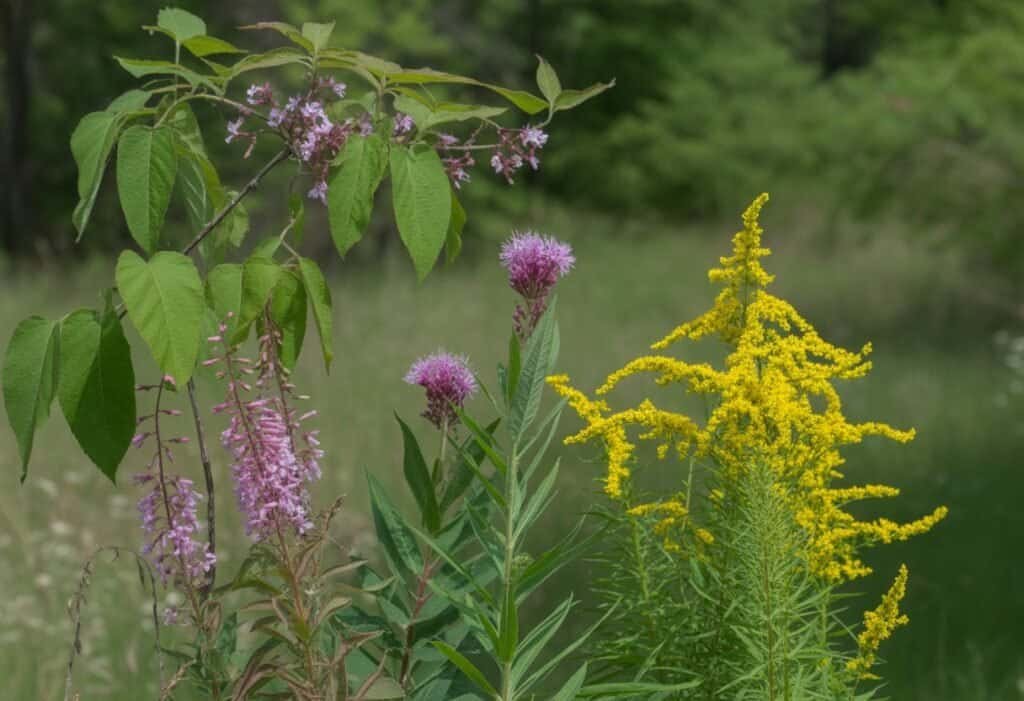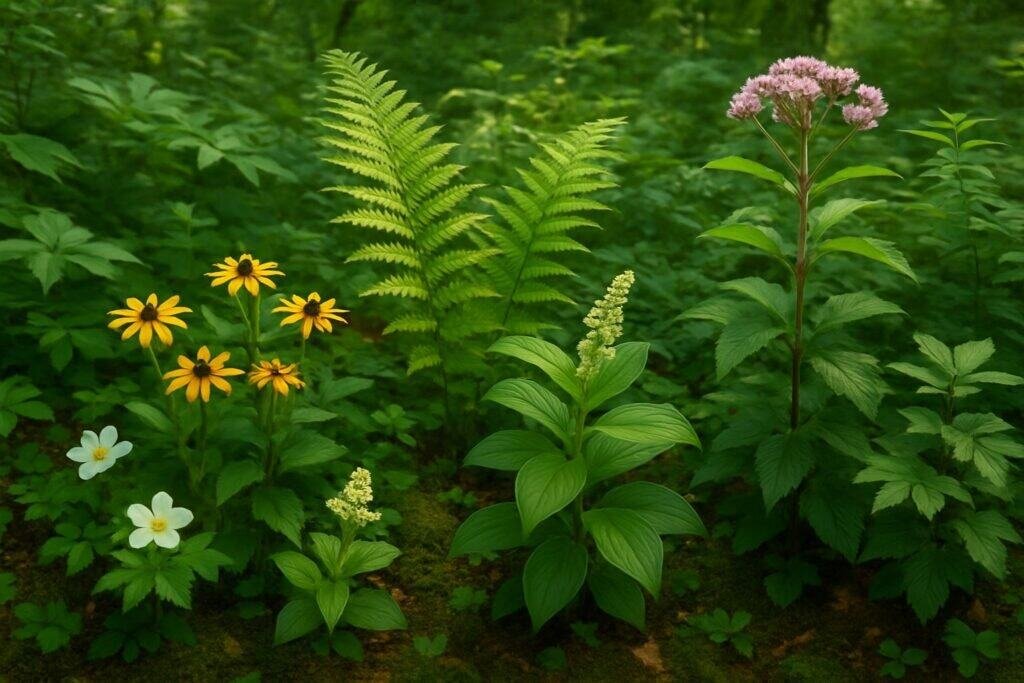New York’s native plant species have evolved here for thousands of years. They create a unique botanical landscape that reflects the state’s diverse environments.
From the Adirondack Mountains to the coastal plains of Long Island, these plants are perfectly adapted to local soils and climate conditions. They also form important relationships with local wildlife.
Choosing native plants for your New York garden creates a beautiful, low-maintenance landscape. Native plants provide essential habitat for local pollinators and wildlife.
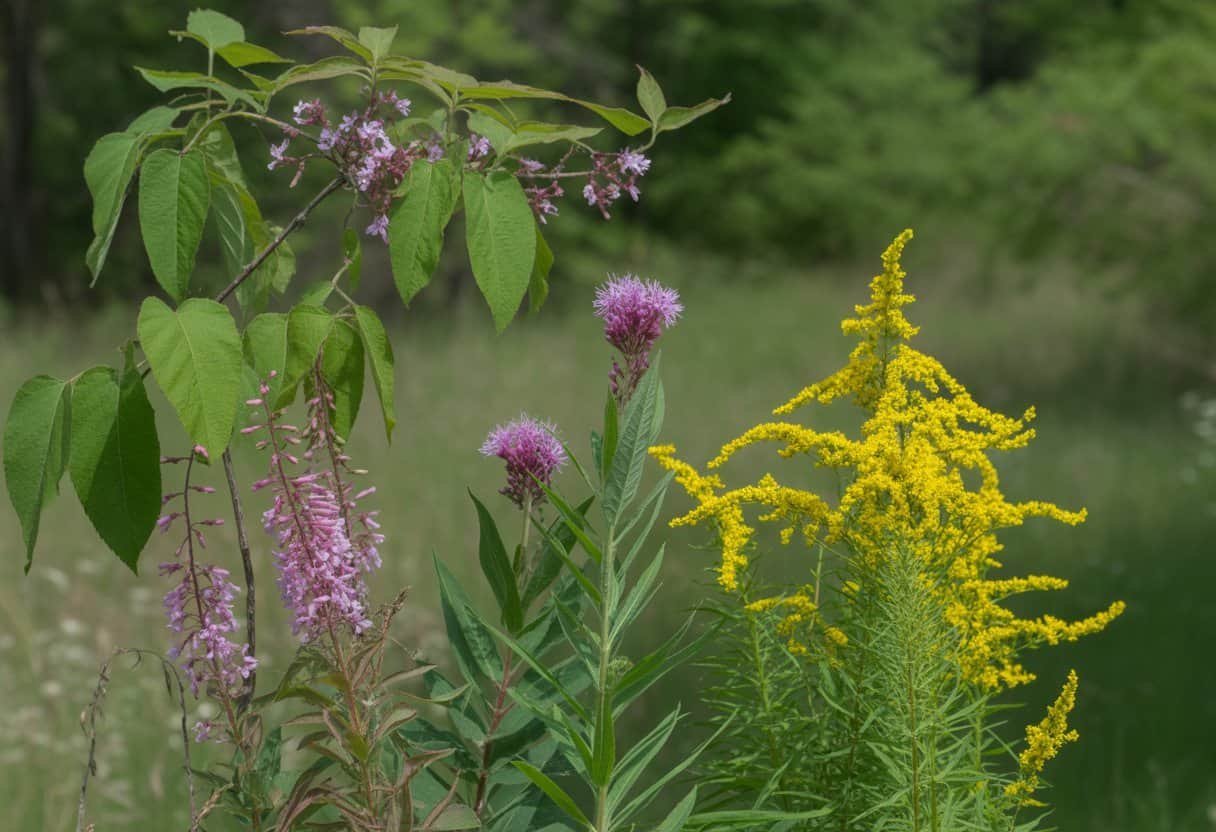
These indigenous plants come in all shapes and sizes. Vibrant wildflowers like Black-eyed Susan and Cardinal Flower, majestic trees such as Red Maple and White Oak, and versatile shrubs like Winterberry and Mountain Laurel all thrive in New York.
Each plant offers something special to the garden. Native species need less water, fertilizer, and care than non-native alternatives.
Key Takeaways
- Native plants are adapted to New York’s climate and soil, making them easier to grow and maintain while supporting local ecosystems.
- Common New York native plants include Cardinal Flower, Black-eyed Susan, Red Maple, and Winterberry.
- Using native plants in your garden helps conserve water, reduce maintenance, and create habitat for pollinators and wildlife.
Understanding New York Native Plants
New York’s landscape features a diverse array of native plants. These plants have evolved to thrive in the state’s unique environmental conditions.
They form the backbone of local ecosystems. Native plants provide essential habitat for wildlife across the region.
Definition and Characteristics
Native plants in New York grew naturally in the region before European settlement. These plants evolved alongside local wildlife and adapted to New York’s climate and soil.
Native plant species usually require less maintenance once established. They have natural defenses against local pests and diseases, so they need fewer chemical treatments.
New York native plants include:
- Trees: Eastern White Pine, Red Maple, White Oak
- Shrubs: Winterberry, Mountain Laurel, Highbush Blueberry
- Wildflowers: Black-eyed Susan, Cardinal Flower, Butterfly Weed
- Grasses: Big Bluestem, Switchgrass, Little Bluestem
These plants have adaptations for New York’s cold winters and variable rainfall.
Regional Ecosystems and Habitats
New York contains several distinct ecosystems. Each one supports different native plant communities.
The Adirondack Mountains feature boreal forests with spruce and fir trees. Coastal plains host salt-tolerant species.
The Hudson Valley contains rich deciduous forests and meadows. These areas support diverse wildflowers and grasses.
Western New York includes unique alvar ecosystems. Specialized plants grow on limestone bedrock there.
Wetland habitats across the state support water-loving plants like cattails, blue flag iris, and swamp milkweed. These areas serve as important wildlife corridors and nesting sites.
Urban areas still have pockets of native habitat in parks and natural areas. However, these spaces face pressure from development and invasive species.
Benefits of Native Plant Species
Native plants provide food and shelter for local wildlife. Berry-producing shrubs feed birds, and native flowers supply nectar for bees and butterflies.
Native plantings help conserve water. Deep root systems absorb rainwater, reduce erosion, and filter pollutants before they reach waterways.
Native plants need fewer resources. They usually require less watering, fertilizing, and pest management than non-native ornamentals.
Using native plants helps preserve New York’s natural heritage and biodiversity. Native plant gardens support wildlife and maintain ecological connections.
Types of New York Native Plants
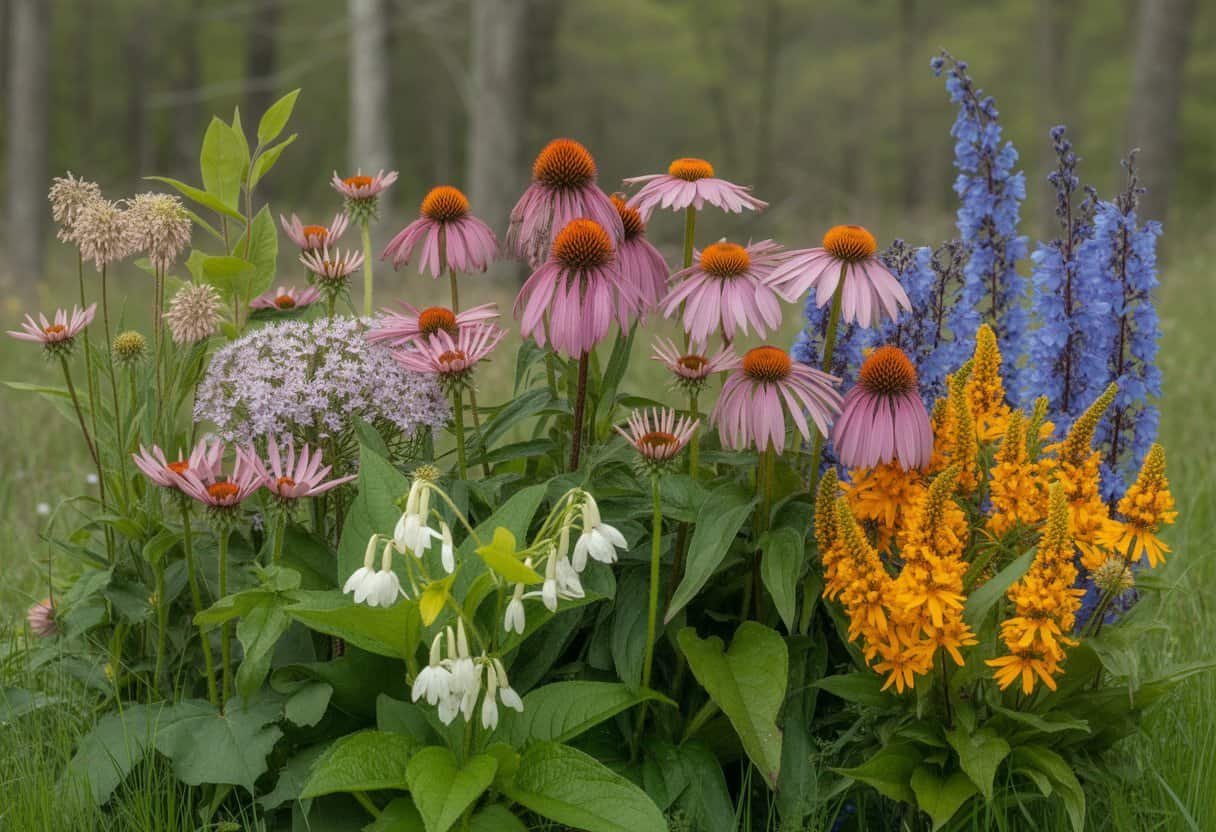
New York state offers a rich diversity of native plants. These native species support local wildlife, require less maintenance, and help preserve the state’s natural heritage.
Wildflowers and Flowering Plants
New York’s landscape features beautiful native wildflowers. The vibrant Orange Butterfly Weed (Asclepias tuberosa) attracts monarchs and other pollinators.
Cardinal Flower (Lobelia cardinalis) displays striking red flowers that hummingbirds love. Wild Columbine (Aquilegia canadensis) shows off red and yellow blooms in spring.
These delicate flowers thrive in woodland edges and rocky areas. Black-eyed Susan (Rudbeckia hirta) brings golden color to meadows with its dark centers.
It’s drought-tolerant and easy to grow. Other native flowering plants include:
- New England Aster (Symphyotrichum novae-angliae)
- Bloodroot (Sanguinaria canadensis)
- Trillium (various species)
- Joe-Pye Weed (Eutrochium purpureum)
These wildflowers offer pollen and nectar for native bees and butterflies.
Shrubs and Deciduous Shrubs
Native shrubs form an important middle layer in New York’s ecosystems. Red Osier Dogwood (Cornus sericea) offers white spring flowers, summer berries, and bright red winter stems.
Witch Hazel (Hamamelis virginiana) blooms with yellow flowers in late fall. Its branches were once used as divining rods.
Popular Berry-Producing Shrubs:
- Highbush Blueberry (Vaccinium corymbosum)
- Winterberry Holly (Ilex verticillata)
- Serviceberry (Amelanchier spp.)
These shrubs provide food for birds and wildlife. They also offer seasonal color changes.
Spicebush (Lindera benzoin) serves as a host plant for the spicebush swallowtail butterfly. Its aromatic leaves give it its name.
New Jersey Tea (Ceanothus americanus) thrives in poor soils. People used it as a tea substitute during the American Revolution.
Trees and Vines
New York’s forests showcase impressive native trees. The Eastern White Pine (Pinus strobus) can reach 150 feet tall and is the state tree.
Sugar Maple (Acer saccharum) provides brilliant fall color and sweet sap for maple syrup. Red Oak (Quercus rubra) grows rapidly, can live for centuries, and produces acorns for wildlife.
Native vines add vertical interest to gardens. Virginia Creeper (Parthenocissus quinquefolia) climbs walls and trees and turns brilliant red in fall.
American Bittersweet (Celastrus scandens) produces orange-yellow capsules that reveal bright red berries in autumn. These berries add color to the winter landscape.
Trumpet Honeysuckle (Lonicera sempervirens) attracts hummingbirds with tubular red flowers. This native vine supports the ecosystem.
Grasses, Ferns, and Groundcovers
Native grasses add movement and texture to New York landscapes. Little Bluestem (Schizachyrium scoparium) forms clumps with blue-green summer color that turns rusty orange in fall.
Switchgrass (Panicum virgatum) creates a strong vertical presence and provides winter interest with airy seed heads. Birds eat its seeds during cold months.
Ferns thrive in New York’s shady areas. Christmas Fern (Polystichum acrostichoides) stays green through winter.
Maidenhair Fern (Adiantum pedatum) displays delicate fronds on black stems. Native groundcovers create living carpets.
Wild Ginger (Asarum canadense) features heart-shaped leaves and curious ground-level flowers. It thrives in woodland settings.
Creeping Phlox (Phlox subulata) covers rocky areas with purple, pink, or white flowers in spring. Wild Strawberry (Fragaria virginiana) offers white flowers, edible berries, and spreads by runners.
Popular Native Plant Species in New York
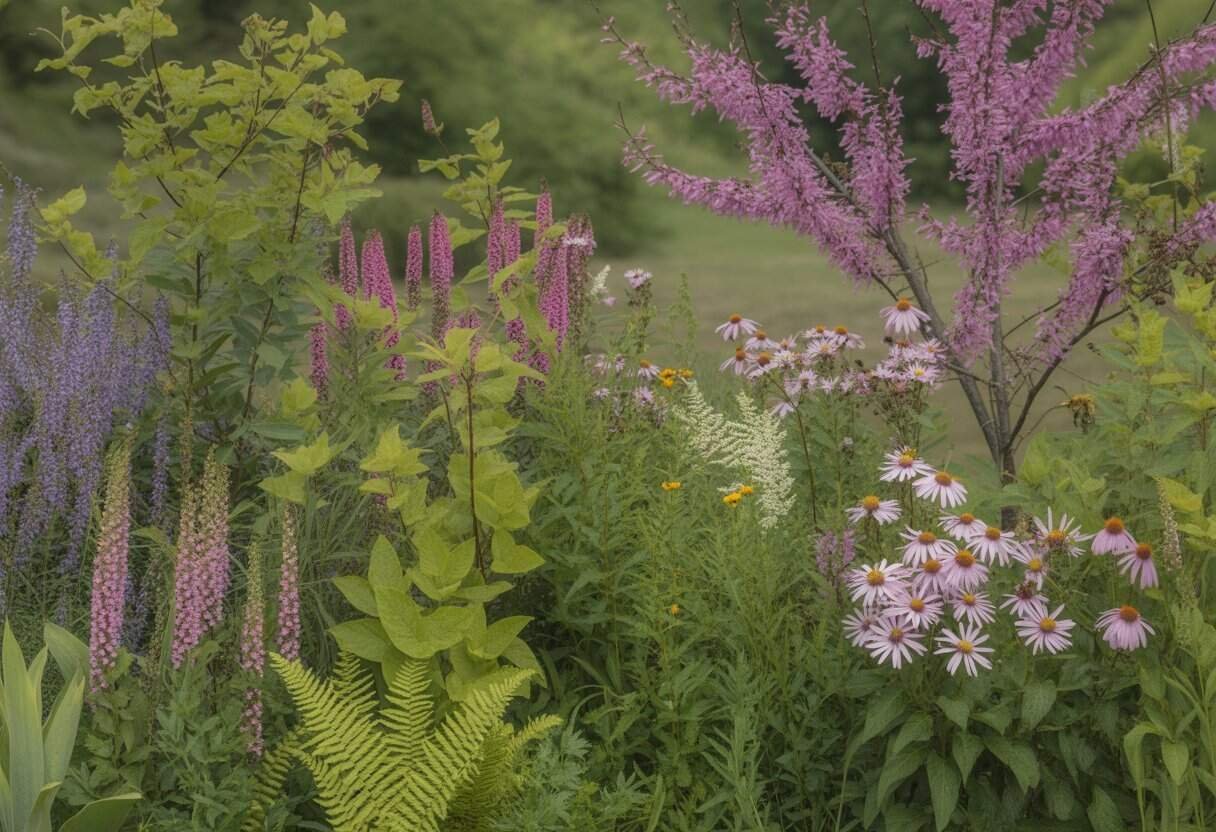
New York’s diverse ecosystems support many beautiful native plants. These species thrive in local conditions and support wildlife.
They require less maintenance and water than non-natives. Native plants provide essential habitat for pollinators.
Great Blue Lobelia and Lobelia Siphilitica
Great Blue Lobelia (Lobelia siphilitica) displays blue flower spikes from July through September. This perennial grows 2-3 feet tall and thrives in partial shade.
It attracts hummingbirds and butterflies. The blue tubular flowers grow in clusters along tall stems.
Great Blue Lobelia adapts well to rain gardens and wet areas. Native Americans used this plant for medicinal purposes, but gardeners now value its ornamental appeal.
It self-seeds moderately and forms attractive colonies. For best results, plant in rich, moist soil.
Pair Great Blue Lobelia with Cardinal Flower (Lobelia cardinalis) for striking color combinations in woodland gardens.
Swamp Milkweed and Butterfly Garden Favorites
Swamp Milkweed (Asclepias incarnata) attracts monarch butterflies with clusters of pink to mauve flowers from June to August. This perennial grows 3-4 feet tall and fits well in organized gardens.
Monarch caterpillars feed only on milkweed plants. The fragrant flowers also attract bees and hummingbirds.
Other butterfly garden favorites include:
- Wild Bergamot (Monarda fistulosa) – lavender flowers and aromatic foliage
- Joe-Pye Weed – tall pink flower clusters in late summer
- Blazing Star (Liatris) – purple spikes that bloom from top down
Sneezeweed (Helenium autumnale) offers golden daisy-like flowers in late summer. It does not cause allergies.
New England Aster and Purple Coneflower
New England Aster (Symphyotrichum novae-angliae) produces purple-pink daisy-like flowers in late summer and fall. It grows 3-6 feet tall and provides nectar for migrating butterflies.
The star-shaped flowers with yellow centers create a beautiful display. Cutting back in early summer encourages bushier growth.
Purple Coneflower (Echinacea purpurea) features cone-shaped centers and drooping pink-purple petals. This drought-tolerant perennial blooms from June through September.
Both plants support beneficial insects. Birds eat their seeds in winter.
Pair with Smooth White Beardtongue (Penstemon digitalis) for spring interest before asters and coneflowers bloom.
Little Bluestem and Native Grasses
Little Bluestem (Schizachyrium scoparium) transforms landscapes through the seasons. It has blue-green summer foliage that turns copper-orange in fall.
This grass grows 2-3 feet tall and tolerates poor soil and drought. Its silver-white seed heads add winter interest.
Birds rely on Little Bluestem seeds for food in winter. Combine it with:
- Canada Anemone (Anemone canadensis) – white spring flowers
- Wild Columbine (Aquilegia canadensis) – nodding red and yellow blooms
- Blue Flag Iris (Iris versicolor) – blue-purple flowers for moist areas
Native grasses need little maintenance. Cut them back in late winter before new growth appears.
Their deep roots prevent erosion and improve soil health. Native grasses also provide essential habitat for wildlife.
Wildlife and Pollinator Support
Native plants of New York provide essential resources for local wildlife. They create thriving ecosystems in gardens and natural areas.
These plants have evolved alongside native animals for thousands of years. Their relationships support biodiversity.
Role in Attracting Pollinators
New York native plants attract pollinators by providing food sources that match their needs. Native flowers produce nectar and pollen that local bees, butterflies, and moths rely on for nutrition.
Bee species like the native bumble bee and mason bee visit plants such as wild bergamot and Joe-Pye weed. These plants offer higher nectar quality than many non-native options.
Butterflies, including monarchs and swallowtails, seek specific native flowers. Monarchs depend on milkweed species, while black-eyed Susans attract various butterfly species.
Hummingbirds favor tubular flowers like cardinal flower and bee balm. These flowers evolved shapes that match hummingbirds’ long beaks and feeding habits.
Supporting Birds, Mammals, and Insect Pollinators
Native plants support wildlife by creating complete habitat systems for various animals. Berry-producing shrubs like serviceberry and winterberry holly offer food for birds in different seasons.
These berries have higher fat content than many non-native alternatives. Purple coneflower seeds feed finches in fall, sunflowers provide food for chickadees, and asters support late-season insect activity.
Native grasses create shelter for small mammals like rabbits and voles. These animals find protection within the dense growth patterns of switchgrass and little bluestem.
Deer also benefit from native plant communities. Gardeners sometimes use deer-resistant natives like bayberry to minimize browsing damage.
Host Plants and Habitat Value
Native plants serve as essential host plants for insect reproduction. Many butterflies and moths can only lay eggs on specific native plant species.
Monarch caterpillars eat only milkweed leaves, while spicebush swallowtail caterpillars need spicebush or sassafras. Without these host plants, these species cannot complete their life cycles.
Oak trees support over 500 species of caterpillars. These caterpillars become food for birds, creating an important food web connection.
Native plants also provide nesting materials and shelter. The hollow stems of plants like Joe-Pye weed offer winter homes for beneficial insects.
Dense native shrubs like arrowwood viburnum create protective nesting sites for birds. These shrubs shelter birds from predators and harsh weather.
Gardening with New York Native Plants
Native plants offer New York gardeners sustainable, low-maintenance options that support local ecosystems. These plants have adapted to the region’s climate and soil conditions over thousands of years.
Soil Types and Moisture Needs
New York’s diverse landscapes create varying soil conditions. Eastern regions often have acidic soils where plants like Mountain Laurel and Winterberry Holly flourish.
Western and central areas may have more alkaline soils, perfect for New York Ironweed and Wild Bergamot. Moisture requirements also vary widely among native plants.
Wet soils: Cardinal Flower, Blue Flag Iris, and Swamp Milkweed thrive near ponds, streams, and marsh areas.
Moist soils: Turtlehead, Joe-Pye Weed, and New York Aster prefer consistent moisture but not standing water.
Well-drained soil: Butterfly Weed, Black-eyed Susan, and Little Bluestem grass tolerate drier conditions.
Test your soil before planting to determine its composition and pH. Most native plants prefer soil that’s rich in organic matter, so adding compost can improve growing conditions.
Sunlight Preferences and Temperature
New York native plants have evolved to thrive in specific light conditions. Full sun plants include Prairie Blazing Star, Wild Lupine, and Goldenrod.
Partial shade plants include Wild Columbine, Solomon’s Seal, and Wild Geranium. Full shade plants like Foamflower, Christmas Fern, and Wild Ginger thrive with less sunlight.
Species like Bearberry and Chokeberry can withstand cold winters in zones 3-4. New York Ironweed and Blazing Star handle summer heat in zones 6-7.
Plant in groups according to similar light needs for best results. Some plants, like Virginia Bluebells, bloom early before tree canopies leaf out to take advantage of spring sunlight.
Garden Design: Pollinator, Shade, and Rain Gardens
Creating specialized native gardens addresses ecological needs and landscape challenges. Pollinator gardens attract beneficial insects and birds with nectar-rich plants.
Combine Bee Balm, Purple Coneflower, and New York Aster to provide blooms from spring through fall. Include a variety of flower shapes and sizes to support different pollinator species.
Shade gardens transform difficult areas under trees into vibrant spaces. Woodland natives like Foamflower, Wild Ginger, and Solomon’s Seal create lush groundcover that thrives in low light.
Rain gardens manage water runoff while creating habitat. Position these in low areas where water collects.
Include moisture-loving plants like Blue Flag Iris near the center, with Cardinal Flower and Switchgrass in middle zones. Layer plants of different heights to create visual interest and maximize wildlife benefits.
Using Native Plants in Borders and Rock Gardens
Native plants excel in traditional landscaping applications like borders and rock gardens. For borders, plant tall species like New York Ironweed and Switchgrass at the back.
Add medium-height plants like Bee Balm and Black-eyed Susan in the middle. Edge with low-growing Wild Strawberry or Pennsylvania Sedge.
Rock gardens showcase drought-tolerant natives that thrive in well-drained, sunny spots. Prickly Pear Cactus, Wild Columbine, and Eastern Prickly Pear add texture and seasonal interest among rocks.
Mix clumps of grasses like Little Bluestem with flowering perennials for year-round structure. Choose plants with multiple seasons of interest, such as Chokeberry with spring flowers, summer berries, and fall color.
For small spaces, compact natives like Wild Strawberry, Foamflower, and Pennsylvania Sedge work well in containers or as ground covers between stepping stones.
Seasonal Interest and Aesthetic Qualities
New York native plants offer visual interest throughout the year with diverse colors, textures, and bloom times. These plants thrive in local conditions while providing beauty in gardens and landscapes.
Flower Colors: White, Blue, Lavender, and Yellow
Native New York flowering plants display a remarkable color palette. White blooms appear on Bloodroot and White Trillium in early spring, creating bright spots in woodland gardens.
Blue flowers appear on New York Asters and Blue Flag Iris. These flowers attract pollinators and add cool tones to garden designs.
Yellow flowers brighten gardens with Golden Alexanders and Black-eyed Susans. These blooms persist from late spring through summer.
Lavender flowers appear on New York Ironweed and Wild Bergamot, adding soft purple hues to the summer and fall landscape.
Fragrance, Foliage, and Texture
The fragrance of native plants enhances the garden experience. Sweet Fern releases a spicy aroma when brushed, while Sweetbay Magnolia offers lemony scents.
Foliage varies dramatically among New York natives. Ferns provide delicate, feathery textures in shady spots, while grasses like Little Bluestem create movement and sound in the breeze.
Plant size ranges from tiny woodland flowers like Hepatica to tall Joe-Pye Weed. This variety allows for multi-layered plantings.
Textural elements include the fuzzy leaves of Pussytoes, smooth waxy surfaces of Wintergreen, and the leathery foliage of Christmas Fern that remains green year-round.
Bloom Times and Seasonal Appeal
Spring welcomes early bloomers like Virginia Bluebells and Spring Beauty. These plants take advantage of sunlight before tree canopies leaf out.
Summer brings color with Butterfly Weed and Bee Balm. These plants support abundant pollinator activity during peak growing season.
Fall features late-blooming asters and goldenrods. New England Aster provides critical late-season nectar for migrating Monarch butterflies.
Winter interest comes from seed heads, berries, and evergreen foliage. Red Chokeberry displays persistent red fruits, while Little Bluestem grass turns coppery orange in winter.
Care, Maintenance, and Sustainability
Native New York plants require specific care approaches that differ from non-native species. With proper maintenance, these plants can thrive while supporting local ecosystems and reducing resource use.
Low-Maintenance Gardening
Native plants typically need less maintenance than exotic species because they’ve adapted to local conditions. Once established, most New York natives need minimal watering beyond natural rainfall.
Group plants with similar water needs together to create efficient watering zones. This practice, called hydrozoning, prevents overwatering some species while underwatering others.
Most native plants don’t need fertilizers once established. Mulching with 2-3 inches of organic material helps retain moisture, suppress weeds, and gradually adds nutrients to the soil.
Dealing with Pests and Diseases
Native plants generally resist local pests and diseases better than non-natives. They have evolved alongside these challenges for thousands of years.
When issues arise, start with the least invasive solutions. Physically removing pests or using water sprays often works for minor infestations.
Common New York Plant Pests:
- Aphids
- Japanese beetles
- Deer
- Slugs
Encourage beneficial insects like ladybugs and lacewings for natural pest control. Plant wild bergamot and New York ironweed to attract these helpful insects.
For diseases, ensure proper air circulation by spacing plants appropriately. Avoid overhead watering to reduce disease risk.
Pruning, Fertilizing, and Saving Seeds
Prune native shrubs and trees during dormant seasons (late fall to early spring) to minimize stress. Remove dead, damaged, or crossing branches to maintain natural growth patterns.
Many native perennials benefit from being cut back in early spring rather than fall. The standing stalks provide winter habitat for beneficial insects.
Save seeds from native plants in late summer to fall when seed heads have dried. Store them in paper envelopes in a cool, dry place.
If fertilizing is necessary, use organic options like compost tea. Apply sparingly in early spring before new growth begins.
Cultivars, Propagation, and Long-Term Success
Some cultivars of native plants (nativars) retain ecological benefits while offering different colors or growth habits. Choose those closest to the original species for maximum ecological value.
Propagation Methods for Native Plants:
- Division (spring/fall)
- Stem cuttings (summer)
- Seed starting (fall/winter)
Document your garden’s progress to track which species thrive in specific locations. This information helps with long-term planning and adjustments.
Create plant communities rather than isolated specimens. Native plants evolved to grow together and support each other through various seasons and conditions.
Protecting and Promoting Native Plant Diversity
New York’s native plant heritage faces challenges from development, invasive species, and climate change. Efforts across the state aim to preserve these vital botanical resources.
Conservation Efforts in New York
The New York State Department of Environmental Conservation (DEC) leads many initiatives to protect native plants. Their Natural Heritage Program tracks rare species and supports conservation planning.
The New York Flora Atlas documents plant distribution and helps scientists identify areas needing protection. Several preserves, including the Albany Pine Bush and Long Island’s Hempstead Plains, focus on plant conservation.
Many restoration projects remove invasive species that threaten native plants. In the Adirondacks, efforts to control purple loosestrife help protect wetland natives like blue flag iris and swamp milkweed.
The New York Natural Heritage Program maintains a watchlist of vulnerable plant species. This list includes heartleaf plantain, northern monkshood, and other rare native plants.
Supporting Local Ecosystems and Biodiversity
Native plants form the foundation of healthy ecosystems. They provide food and habitat for local wildlife, especially specialist pollinators that evolved alongside specific plant species.
Home gardeners play a crucial role by creating native plant gardens. Even small urban yards in New York City can support monarch butterflies with milkweed or songbirds with native berries.
Benefits of native plant landscaping:
- Requires less water and maintenance
- Eliminates need for fertilizers and pesticides
- Creates wildlife habitat
- Preserves local botanical heritage
Native plant corridors connect fragmented habitats. These pathways allow wildlife to travel between larger natural areas, supporting genetic diversity and resilience.
Resources and Organizations for Native Plants
The Native Plant Trust offers educational programs and plant sales throughout New York. Their Go Botany website helps people identify native species for different growing conditions.
Local chapters of Wild Ones and the Native Plant Society support native plant enthusiasts. These groups organize seed exchanges, garden tours, and restoration volunteer days.
Several botanical gardens showcase native plant collections:
- Brooklyn Botanic Garden’s Native Flora Garden
- New York Botanical Garden’s Native Plant Garden
- Cornell Botanic Gardens’ Mundy Wildflower Garden
Many nurseries now specialize in locally-grown native plants. These nurseries help gardeners find plants suited to specific regions within New York.
The Pollinator Pathway initiative connects property owners who create native plant habitats. This growing network spans many New York communities and supports pollinators.
Frequently Asked Questions
New Yorkers often have questions about using native plants in their gardens and landscapes. These plants offer ecological benefits and thrive in local conditions with minimal maintenance.
What are some common native plants found in New York State?
New York hosts a wide variety of native plants adapted to its landscapes. Butterfly weed (Asclepias tuberosa) grows in meadows and attracts monarch butterflies with bright orange flowers.
Wild columbine (Aquilegia canadensis) thrives at woodland edges and displays red and yellow blooms in spring. Eastern purple coneflower (Echinacea purpurea) creates purple displays and supports native pollinators.
New York ironweed (Vernonia noveboracensis) grows tall in moist areas and attracts butterflies with deep purple flower clusters. Woodland phlox (Phlox divaricata) carpets forest floors with fragrant blue flowers in spring.
Where can one purchase native plants suitable for New York landscapes?
Several specialized nurseries across New York offer locally-adapted native plants. Native plant societies often hold seasonal plant sales with species suited to the region.
The New York Native Plant Center in Westchester County maintains a large selection of indigenous plants. Many local botanical gardens, including the Brooklyn Botanic Garden and New York Botanical Garden, host annual native plant sales.
Online retailers like Prairie Nursery and Prairie Moon Nursery ship native plants suitable for New York gardens. Community seed libraries sometimes provide native plant seeds collected from local areas.
Which native plants are recommended for urban gardening in New York City?
Urban environments need tough plants that tolerate pollution and varied light. Black-eyed Susan (Rudbeckia hirta) grows well in city gardens and provides yellow flowers even in poor conditions.
New York aster (Symphyotrichum novi-belgii) adapts to container gardens and rooftops and attracts late-season pollinators. Common milkweed (Asclepias syriaca) supports monarch butterflies and grows in urban community gardens.
Virginia creeper (Parthenocissus quinquefolia) provides vertical greenery for walls and fences in small city spaces. Wild strawberry (Fragaria virginiana) makes a good ground cover for small urban patches with partial sun.
What native trees thrive in New York’s climate and soil conditions?
Red maple (Acer rubrum) grows in various soil conditions and provides brilliant fall color. Eastern white pine (Pinus strobus) thrives in upstate regions and offers year-round greenery and wildlife habitat.
River birch (Betula nigra) tolerates wet conditions found in many New York landscapes. Flowering dogwood (Cornus florida) produces spring blossoms and grows in woodland understories across the state.
Serviceberry (Amelanchier canadensis) provides spring flowers, summer berries, and fall color. These smaller native trees work well in limited spaces and provide food for birds.
How can I identify flowers that are indigenous to upstate New York?
Field guides for northeastern flora provide illustrations and identification keys. The New York Flora Atlas (nyflora.org) offers a searchable database with photos and maps.
Plant identification apps like iNaturalist help users identify native species using photos. Local nature centers often lead wildflower walks with botanists who know regional species.
Features like leaf arrangement, flower structure, and growth habit help distinguish native species from non-natives. Master Gardeners at Cornell Cooperative Extension can assist with plant identification.
Where can I find a comprehensive list of plants native to New York?
The New York Flora Association maintains a database of native plants categorized by region and habitat.
Cornell University’s native plant database offers searchable information on species suited to different growing conditions.
The Brooklyn Botanic Garden publishes guides on New York native plants and provides details about their ecological benefits.
The New York Natural Heritage Program documents rare and common native plants with distribution information.
The Native Plant Trust includes New York in its Go Botany online identification tool and database.

